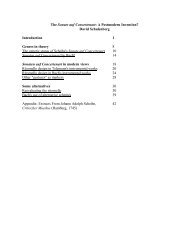SEVEN PAPERS ON EXISTENTIAL ANALYSIS ... - Wagner College
SEVEN PAPERS ON EXISTENTIAL ANALYSIS ... - Wagner College
SEVEN PAPERS ON EXISTENTIAL ANALYSIS ... - Wagner College
Create successful ePaper yourself
Turn your PDF publications into a flip-book with our unique Google optimized e-Paper software.
V. Therapeutic Validation in Existential Analysis (2002)<br />
first published in Existential Analysis 13(1), 2002, pp. 144-158.<br />
Note: This article is a discussion of the principal goal of existential analysis: revalidation of the<br />
analysand’s existence and its relation to change. The case study of a 19-year old male college<br />
student is presented.<br />
_____________________________________________<br />
The Goal of Existential Analysis<br />
Remarkably, little has been written about technique in psychotherapy and what is there is<br />
uniformly disappointing. There may be a good reason for this, namely, that there is no such thing<br />
as psychotherapy technique (1). For now, I will not go that far, although there may be good<br />
reasons for doing so.<br />
Apart from what to avoid doing, which traditionally has been an important theme of the<br />
so-called supervision process in clinical training, the psychotherapist is given little guidance<br />
about how to proceed in his work with clients. Offering the client unconditional positive regard<br />
(Carl Rogers) is more about the personality of the therapist than about his technique. After all,<br />
full attentive engagement with the client must be as much a matter of manners as anything.<br />
Evenly suspended attention (Freud) is probably equivalent to such attentiveness. It speaks to the<br />
conditions of effective work with analysands but says nothing about what to do.<br />
In part, the absence of technical recommendations is due to the fact that the outcome<br />
of psychotherapy is not easily defined. If one applies a technique, it must be to some end, but if<br />
the end is not clear, how can one rationally make technical recommendations? On the other<br />
hand, if as Freud says, the result of psychoanalysis is the capacity for love and work, or as Jung<br />
says, the goal of analytical psychology is individuation, the meaning of these goals is so general<br />
that, when considering what to do, the therapist has little to envision at the horizon of<br />
therapeutic work with a client. Other forms of counseling and psychotherapy claim that<br />
adjustment is their goal, but, surely, if that means the absence of all conflict, it is not desirable as<br />
a goal, as the elimination of anxiety is not, since anxiety in moderation is an essential feature of<br />
human life. In the final analysis, we must also ask: Are any of these goals assessable and<br />
measurable? Probably not. And what scientific sense can be given to patient satisfaction?<br />
In contrast with other therapeutic modalities, existential analysis holds that its goal is the<br />
freedom of the existential analysand (2). While this is also an outcome that is difficult to assess, it<br />
is not more difficult to assess than the broad outcomes of Freudian or Jungian analysis, but unlike<br />
these forms of psychotherapy, it may be possible to identify a concrete therapeutic intervention<br />
within the practice of existential analysis that is at the same its primary therapeutic goal. I will call<br />
this intervention the reinvestiture of existence, which I define as a moment modeled on a<br />
fundamental experience of human development, the conferral of existence during infancy.<br />
While the latter is basic for becoming human, in existential analysis, therapeutic efficacy<br />
results from reaffirming in the patient the clearing nature of being human. For the existential<br />
analyst, a person seeks therapy usually because her world has dimmed The reinvestiture of her<br />
existence permits things to once again speak to the analysand. Her world regains some of the<br />
luminance of childhood, in which there is more to be seen than at any other time in life. In the<br />
course of passage through adolescence and adulthood, sectors of the world systematically<br />
darken. Or, to use another metaphor, things say less or speak more quietly to us as the demands<br />
of socialization grip us ever more tightly. As a result of cultural indoctrination, the child's<br />
fascination with the world is systematically replaced by limiting ways of looking at the world,<br />
most of them the result of the dominance of language, which permits things to be seen only as















